Visiting Nuremberg, a German twin-city opening its arms to Shenzhen for two decades
Writer: Bin Zhou, Jingrong Fan, Wenrong Jin | Editor: Doria Nan | From: Shenzhen Special Zone Daily | Updated: 2018-12-31
A+ A- Print
[Editor’s note:]The one-thousand-year Imperial City Nuremberg in the north of Bavaria, Germany, may not be a popular destination to Chinese tourists, but it is one of the earliest twin-cities of Shenzhen and the official twin-city ties have been knotted for 21 years since 1997 as an endeavor to promote opening-up and inter-city collaboration globally.
In the mid-winter of 2018, Shenzhen Special Zone Daily launched a special edition to cover the business and cultural cooperation between Shenzhen and its twin-cities worldwide as a dedication to the 40th anniversary of China’s Reform and Opening-up, which was initiated in 1978 and hence transformed the then-small-county Shenzhen into an international metropolitan.
When arrived at Nuremberg, Shenzhen Special Zone Daily found that its irresistible glamour as a historical city, business hub and innovation center is yet to be explored despite of frequent cultural and business exchanges between it and Shenzhen in the last 21 years.
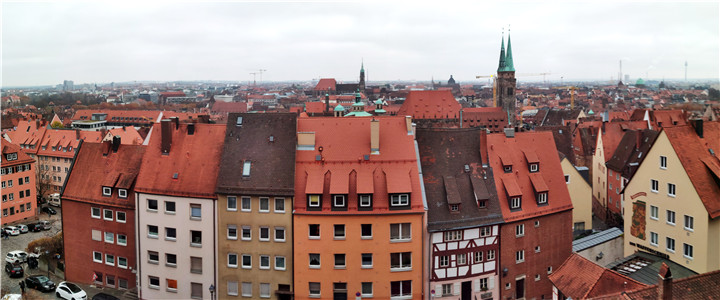
Nuremberg. Photos by Yubo Wang.
In the prosperousplains of Bavarian, the beautiful andancient city of Nuremberg emerged since the11th century.
She is the home of Albrecht Dürer, the cradle of the German Renaissance. Tolocal residents, Dürer, one of the most dazzling master painters of the European Renaissance, could be comparable to Leonard Da Vinci. His former residence in the old town has so far attracted worship from tourists all over the world.
She is a European business hub since the Middle Ages, the birthplace of modern enterprises such as Siemens and AEG after Industrial Revolution, andstill the famous “toy capital” and its Christmas market, the Christkindl Market, resembles traditions from the 11th century and is still the largest in Germany.
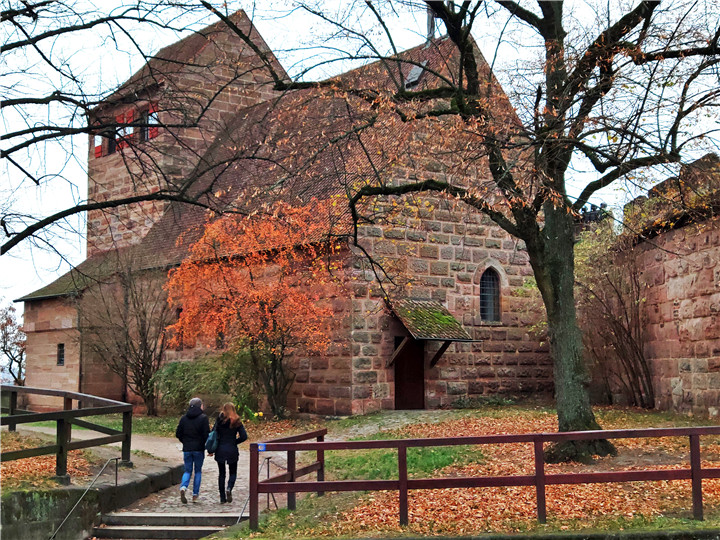
Nuremberg, which may sound unfamiliar to some Chinese tourists, is already an old friend to Shenzhen people. In the mid-winter days, reporters of Shenzhen Special Zone Daily visited Nuremberg andwere deeply impressed by her profound historical and cultural atmosphere. Yields from two-decades friendship between Nuremberg and Shenzhen could be witnessed here and there, and above all, the openness and tolerance of Nuremberg and its way from a post-war victim to a European metropolitan is a great inspiration for us to carry on the opening-up policy.
Art as part of life and major cultural exchanges
The Meistersinger Hall Nuremberg, which is named after Wagner's opera Die Meistersinger Von Nürnberg, 1868, is located next to a sports park outside the ancient city. During the Second World War, the venue was used as a square for Nazi gatherings. It is said that after the war, the citizens of Nuremberg decided to build the place into a park, which is to commemorate and call for peace.
At 4 o'clock in the afternoon, the Nuremberg choir, Hans-Sachs-Chor, and the Nuremberg Conservatory Symphony Orchestra were to hold a concert here. Our reporters just caught up with the last rehearsal of the crew before noon. The orchestra's conductor is Professor Rumstadt, director of command departmentof Nuremberg Conservatory.He is also the chairman of the German conductor association, the director of the Nuremberg National Opera, and co-chairman of the Nuremberg Shenzhen Friendship Association.
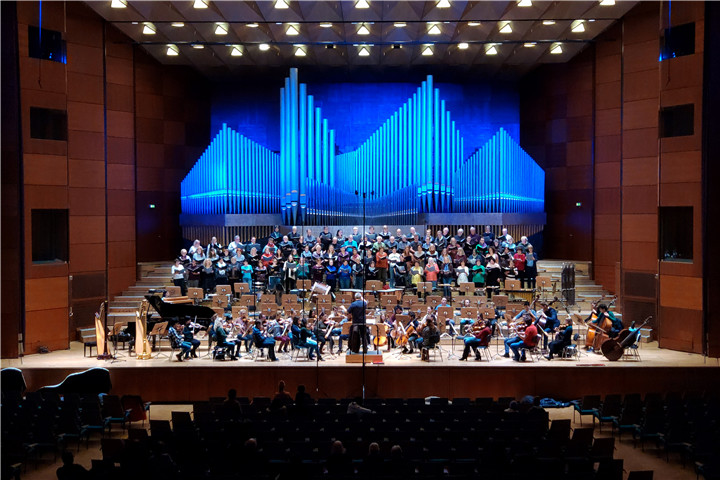
Rehearsal of Hans-Sachs-Chor
The music rang, and the sound of the heavenly harmonies gradually filled the theater, like a warm bubble, which isolated the winter's cold.
Dr. Wang Huanhuan, the co-chairwoman of the Nuremberg Shenzhen Friendship Association, told reporters that in Sister-city exchange activities in Nuremberg, art and cultural exchanges also occupied an important part. The art groups of the two cities often visited each other and exchanged performances. The Chinese artists and the Nuremberg Orchestra jointly participated in the performance of Nuremberg New Year Concert. The concert has become a local signature concert, full of people every year, deeply rooted in the hearts of the people.
"Music is the best bridge for human communication," Wagner's famous quote was fully explained in Nuremberg. The Nuremberg city is small compared to most cities in China, but it set up a concert hall and an opera house. There are more than 100 performances each year, and some of them were exported to stages at Shenzhen. Nuremberg's name is already familiar to many fans in Shenzhen.
There are more than 40 large and small museums in Nuremberg, and the German National Museum is the largest one of German culture and art. Every May, Nuremberg hosts the “Blue Night” art festival when the whole city will be ornamented and dressed in blue andthe museums offer numerous cultural festivities.
From ancient trade town to modern cosmopolitan
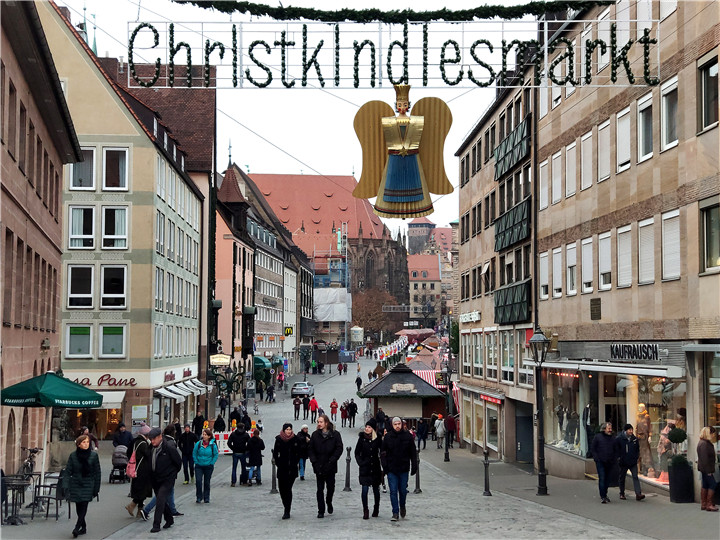
Stepping into the ancient city of Nuremberg with a thousand years of history, reporters soon noted that the Market Square was almost fully occupied by rows of red-and-white striped booths. It is told that the annual Christmas market in Nuremberg is about to open, when the whole city will be filled with the aroma of “Gluehwein”, a spiced mulled wineof German origin, mixed with the taste of Nuremberg special gingerbread. The market attracts 2 million tourists from all over the world before Christmas every year, and there is a special area for Nuremberg’s twin-cities. The booth for Shenzhen sells toys and festival decorations and ornaments.
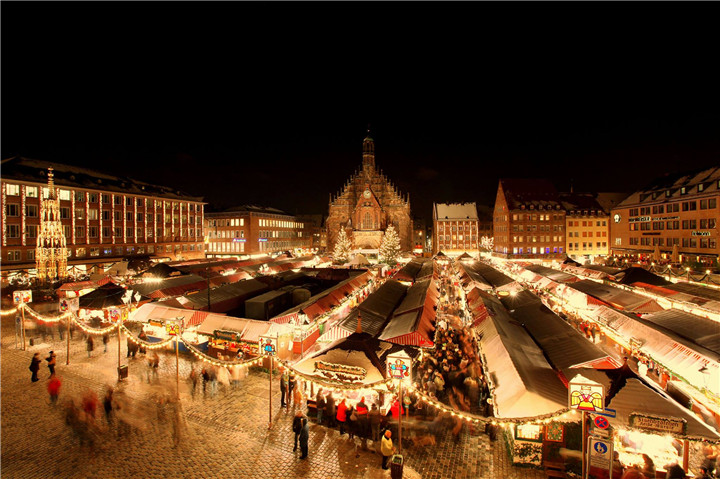
Courtesy of Nuremberg government.
Indeed, Nuremberg is artistic and business-minded; it is ancient but with the modernity of always keeping up with the times.
Song Linhong, manager of the Shenzhen Office of the European Economic and Trade Office, said that the representative office is based in Nuremberg because it is not only an ancient city with a long history, but also an important economic center in southern Germany. It is the second largest city in Bavaria after Munich and an innovation center with its good infrastructure, renowned universities and research institutions in the Nuremberg Region, such as the University of Erlangen-Nuremberg.
Nuremberg was founded around 1040 by the order of Heinrich III, and designated as the Imperial City by Emperor Charles IV in 1356. It has been a prosperous business hub as the trade route to east must pass through Nuremberg at the time and there was once a saying that “Nuremberg goods are all over the world”.
During the Industrial Revolution, the first German train traveled between Nuremberg and Furth in 1835. The rising of machinery, electrical production and bicycle and toy manufacturing turns the city into a major economic center in Southern Germany, including the foundation of Siemens, AEG and Staedtler and so on.
As an active advocator of the internationally twin-city relationship, Nuremberg committed a lot in promotion of economic cooperation between Nuremberg and Shenzhen, which in turns boosts confidences of German companies in Shenzhen. For example, renown companies such as Lufthansa, TUV, and 3D printing giant EOS all have set up branch offices in Shenzhen.
It is also true on the other way around. In 2015, Shenzhen Skyworth Group acquired Metz, a German high-end TV manufacture whose factory is located inZirndorf in Nuremberg Region. Wang Guangchao, deputy general manager of Metz blue, said that Skyworthhas learned a lot from its German partner especially their high demand on technology, industrial design, product quality and customer services.
Open to the international world for a bright future
In January 1945, the Allied Air Force blew up nearly 90% of the buildings in Nuremberg. After the war, the citizens of Nuremberg chose to rebuild the ancient city according to the original appearance, including the old city hall. The Nazi Documentation Center was established near the unfinished congress building of the Nazis, and the Nuremberg Trial Court Museum was set up on the site of the famous Nuremberg trial after the war. A large number of documents were displayed, revealing how the national enthusiasm seemingly for the good of people was deliberately turned intototalitarian and terrific crimes against humanity.
Facing into the dark sides of history, Nuremberg integrated itself into the new world economic structure after the war with an open, tolerant and friendly attitude. It has nearly one-third of the migrant population, establishestwin-city relationship with 21 cities around the world, and actively initiates and participates in various twin-city exchange activities.
The Nuremberg Region and Shenzhen formally established a twin-city relationship in 1997, one of the earliest of its kind in Shenzhen. Since then, numerous events and activities were launched between the two cities, which laid solid foundations for a “classic and role of model” twin-city relationship as defined by Mayor of Nuremberg, Ulrich Maly.
Nowadays, the Chinese community in Nuremberg is growing and Chinese language services are also getting more popular as in the Nuremberg Tourists Center and Nuremberg Trail Museum, which is not common in many German cities.
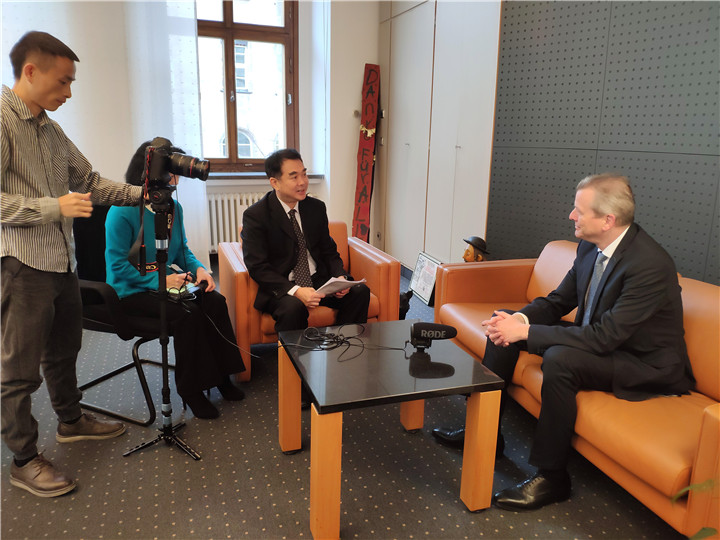
Mayor Maly with Shenzhen reporters
Mayor Maly himself has visited Shenzhen several times, and the last one was in May 2017. He warmly received reporters from the Shenzhen newspaper and showed confidence to further cultural exchanges and business cooperation between the two cities.
“Nuremberg is small and cannot develop as fast as Shenzhen, which almost looks like a new city in every 5 to 6 years. We are very happy to see that the life and environment qualities are also improving in Shenzhen.” said Maly. He believes that by learning from each other and work with each other, the international community will share a peaceful world and better future. (Translated by Jennifer Fan)